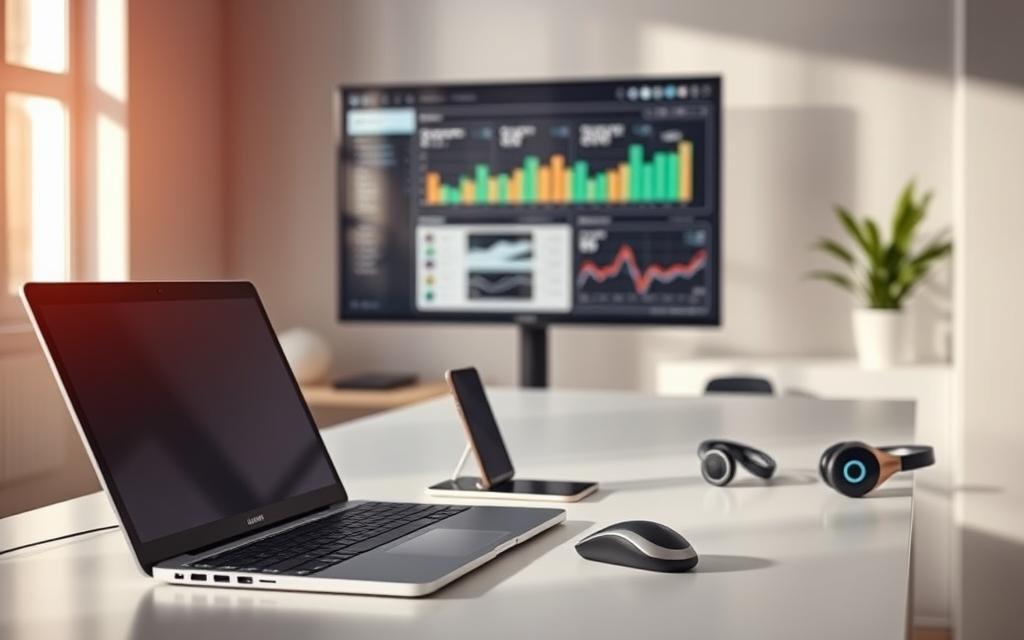Ever feel like there aren’t enough hours in the day? You’re not alone. Getting things done efficiently isn’t just about working harder—it’s about working smarter. Whether you’re tackling daily tasks or long-term goals, small changes can lead to big results in both your personal and professional life.
For businesses, improving output per hour worked (a key measure of labor productivity) directly impacts success. McKinsey research shows companies that prioritize efficiency see up to 30% faster growth. On a national level, this drives economic progress—higher gross domestic product means better living standards for everyone.
In this guide, you’ll discover practical ways to streamline workflows using proven time management techniques. We’ll explore tools that help maintain focus and energy, while balancing health with high performance to sustain momentum.
Ready to transform how you approach your day? Let’s dive in!
Understanding Productivity: Definition and Impact
Efficiency shapes success in ways we often overlook. Whether you’re tackling daily chores or leading a team, how you use resources determines outcomes. Let’s break down what this means for individuals and organizations.
What Does Productivity Mean?
At its core, productivity measures output relative to input. For example, finishing three projects in four hours shows better efficiency than completing one. Companies calculate this through metrics like revenue per employee or labor productivity formulas comparing goods/services produced to hours worked.

Why Efficiency Drives Results
Higher efficiency means achieving more with less—like using automation to reduce manual tasks. Research shows businesses focusing on streamlined processes grow 30% faster. Three key factors fuel this:
- Clear expectations and measurable goals
- Employee engagement through recognition programs
- Investments in tools that reduce wasted effort
On a personal level, balancing energy and focus helps maintain momentum. A McKinsey study found workers who set daily priorities complete 28% more tasks. Success hinges on aligning individual habits with organizational strategies—proving smart effort beats raw hustle every time.
Setting Clear and Achievable Goals
What separates high achievers from perpetual planners? Clear targets. Research from Dominican University shows people who write down specific objectives are 76% more likely to hit them. This approach works for both personal growth and company-wide strategies.

- Specific: “Write 500 words daily” beats “Work on writing”
- Measurable: Track sales calls made, not just “improve numbers”
- Time-bound: Set weekly checkpoints for project phases
Companies using this framework report 23% fewer missed deadlines. Why? Breaking big projects into daily tasks prevents overwhelm. A marketing team might divide a quarterly campaign into weekly content batches instead of racing last-minute.
Clarity in goals directly impacts labor productivity. When teams understand priorities, they spend 17% less time on low-value work according to Harvard Business Review. Start small—define one key target today, then build momentum with bite-sized steps.
Mastering Time Management Techniques
Ever wonder why some days feel chaotic while others flow smoothly? The difference often comes down to intentional planning. A Stanford study found workers who structure their time effectively complete 42% more high-impact tasks daily.

Prioritization and Scheduling Strategies
Start by identifying your “big three” daily goals. Project management platform Asana reports teams using this method reduce missed deadlines by 34%. Two proven tactics:
- Time blocking: Assign 90-minute chunks to specific work
- Two-minute rule: Immediately handle quick tasks like emails
Tech company Zapier boosted output 27% after implementing color-coded calendars. Their secret? Matching energy levels to task difficulty—tackling complex projects during peak focus hours.
Overcoming Distractions Throughout Your Day
Notifications cost the average worker 2.1 hours daily. Combat this with:
- App blockers during deep work sessions
- Scheduled email checks (10 AM, 2 PM, 4 PM)
Harvard research shows it takes 23 minutes to refocus after interruptions. Try the “phone flip” method—place devices face down and out of reach. One marketing firm reduced meeting times 40% by using shared digital planners, proving small changes create lasting impact.
Leveraging Technology and Tools for Enhanced Productivity
Imagine cutting your workload in half without working faster. Modern tools make this possible by handling repetitive tasks so you can focus on high-impact work. From project management platforms like Asana to CRM systems like Salesforce, the right tech stack transforms how teams operate.

Automation slashes time spent on routine activities. Companies using tools like Zapier report completing data entry 60% faster. A Forrester study found teams that automate workflows see a 40% boost in output per quarter. Key areas to streamline:
- Document sharing with cloud-based platforms
- Client follow-ups via email sequencing tools
- Progress tracking through visual dashboards
Adoption doesn’t require overhauling existing systems. Start by integrating one tool that solves a specific pain point—like Trello for task visibility. Teams using collaborative platforms complete projects 22% faster according to HubSpot data.
Balance is crucial. Tools enhance human skills but can’t replace creative problem-solving. Pair tech with regular team feedback sessions to refine processes. For best results, test new systems in phases and provide hands-on training to build confidence.
Optimizing Your Work Environment for Success
Your surroundings shape your results more than you think. A well-designed space doesn’t just look good—it fuels better thinking and smoother teamwork. Let’s explore how to craft an environment that supports both individual focus and group success.

Designing an Ergonomic and Inspiring Desk Setup
Proper desk ergonomics reduce physical strain by 40%, according to OSHA studies. Start with chair height—feet should rest flat, knees at 90-degree angles. Position monitors at eye level to prevent neck strain, and use adjustable lighting to minimize eye fatigue.
Add personal touches like plants or artwork. Research shows workers in visually appealing spaces solve problems 15% faster. Keep essentials within arm’s reach to maintain flow states—clutter-free surfaces improve mental clarity.
Fostering a Collaborative and Feedback-Driven Culture
Teams with psychological safety deliver 56% better results (Google’s Project Aristotle). Create open spaces for impromptu discussions, but balance them with quiet zones for focused work. Weekly feedback sessions help align priorities—companies using this method see 30% fewer project delays.
Try these simple shifts:
- Rotate meeting leaders to empower junior staff
- Use digital whiteboards for real-time idea sharing
- Celebrate small wins publicly to boost morale
A tech startup increased output by 22% after redesigning their office with standing desks and collaboration pods. Remember: minor tweaks often yield major efficiency gains.
Developing a Productive Mindset and Healthy Habits
Your brain isn’t a machine—it’s a garden that needs tending. Research reveals workers with positive mental frameworks complete tasks 34% faster than pessimistic peers. The secret? Mindset shapes how we approach challenges, turning obstacles into stepping stones.

Start with morning rituals that fuel both body and mind. Apple CEO Tim Cook begins his day at 4 AM with exercise and protein-rich meals—a routine linked to 22% better focus in neuroscience studies. Three foundational habits create lasting change:
- 7-9 hours of sleep to reset cognitive function
- 20-minute walks to boost creative problem-solving
- Hydration strategies (aim for half your weight in ounces daily)
Microsoft’s Satya Nadella credits meditation with helping teams innovate under pressure. Try the 5-minute reflection technique before critical tasks: close your eyes, breathe deeply, and visualize success.
Balance drives sustainability. A Yale study found employees who disconnect after work hours produce 18% higher quality output. Remember: true efficiency isn’t about endless hustle—it’s creating systems that honor your energy while achieving meaningful results.
Measuring Productivity: Metrics and Methods
What gets measured gets managed—and improved. Tracking efficiency helps businesses scale and individuals grow. Let’s explore practical ways to quantify progress using both economic frameworks and personal systems.
Understanding Labor and Capital Productivity
Companies gauge success through two key metrics. Labor productivity calculates output per hour worked—like a factory producing 100 widgets with 10 staff hours. Capital productivity measures output against equipment or tech investments, such as software generating $50k monthly from a $5k tool.
McKinsey data shows firms using these metrics achieve 18% faster growth. A bakery might track loaves per baker-hour, then reinvest savings into better ovens. This creates a cycle of measurable improvement.
Applying Personal Productivity Measures
Individuals thrive with simple tracking. Try these steps:
- Count completed tasks versus time spent daily
- Rate focus levels on a 1-5 scale during work blocks
- Review weekly outputs to spot patterns
A freelance designer increased project completion by 40% after logging design hours versus client revisions. Adjust strategies monthly—if emails eat 3 hours/day, test batch processing. Remember: data reveals what deserves your energy.
Whether running a company or your day, clear metrics turn effort into results. Start with one measurement this week, then build from there.
Overcoming Productivity Challenges: Tips and Tricks
Hit a wall with your daily workflow? You’re not alone. Studies show workers lose 3 hours daily to avoidable hurdles like multitasking and digital interruptions. Let’s tackle these roadblocks head-on with battle-tested solutions.
Task-switching eats 40% more time than focused work—your brain needs 15 minutes to regain momentum after interruptions. Combat this with:
- Theme days: Designate Mondays for meetings, Tuesdays for creative projects
- Physical timers: Use a visible kitchen clock to maintain task boundaries
- Email windows: Check messages at 11 AM and 3 PM only
A software team at Dell slashed errors by 28% using noise-canceling headphones during coding sprints. Their secret? Creating “focus zones” where team members wear red hats when needing uninterrupted time.
Weekly self-reviews work wonders. Spend 10 minutes every Friday answering:
- Which tasks took twice as long as expected?
- When did I feel most energized this week?
- What one tool could simplify my process?
Industry leaders like Cal Newport swear by the “shutdown ritual”—a 5-minute routine to prep for tomorrow’s priorities. Try writing three key goals on a sticky note before leaving your desk. Small tweaks create big momentum over time.
Enhancing Productivity in the Workplace
How do top-performing teams consistently deliver exceptional results? The answer lies in cultivating environments where people thrive. A Gallup study reveals companies with highly engaged employees see 21% higher profitability—proof that workplace culture directly impacts output.
Start by rethinking physical and psychological spaces. Tech startup Buffer increased project completion rates by 18% after introducing flexible seating arrangements and quiet zones. Three actionable strategies for businesses:
- Implement weekly “innovation hours” for skill-building
- Create peer recognition programs using digital shout-out boards
- Adopt proven collaboration strategies through team productivity platforms
Well-being drives performance. Companies offering mental health resources report 34% fewer sick days according to CDC data. Try midday stretch breaks or mindfulness rooms—simple changes that reduce burnout while maintaining momentum.
Leadership sets the tone. Managers who conduct monthly growth conversations see 27% higher team output (Harvard Business Review). Blend technology with human touchpoints—use project dashboards for transparency but prioritize face-to-face feedback sessions.
Remember: sustainable success comes from aligning people’s strengths with smart processes. Whether running a boutique firm or multinational corporation, small cultural shifts create ripple effects that elevate entire organizations.
Exploring Economic and Global Productivity Trends
Nations racing to boost output face both technological leaps and unexpected hurdles. While South Korea’s AI adoption added $18B to its GDP last year, France saw growth slow due to aging workforces. These disparities highlight how global shifts shape local success.
Technology’s Impact on National Productivity
Automation adds $2.7T annually to G20 economies—but gains vary wildly. The U.S. leads in AI-driven manufacturing with 9.3% annual efficiency jumps, while Latin America struggles with tech access gaps. Three key patterns emerge:
- Countries investing 3%+ of GDP in R&D grow 2x faster
- Workers using digital tools complete 14% more tasks hourly
- AI-powered supply chains reduce waste by 38%
Factors Behind Productivity Slowdowns and Growth
Why did Germany’s output per worker plateau despite heavy automation? Capital investment dropped 12% since 2019, delaying factory upgrades. McKinsey identifies four slowdown triggers:
- Aging populations reducing workforce numbers
- Overregulation in emerging markets
- Skill mismatches in tech-heavy industries
- Energy costs consuming 17% of operational budgets
Smart policies can reverse trends. Japan boosted robotics training programs, creating 90,000 high-skill jobs. Meanwhile, Vietnam’s tax breaks for automation tech attracted $6B in foreign investment last year. Your local bakery’s success now ties to worldwide innovation waves—understanding these forces helps businesses stay ahead.
Conclusion
Transforming how you work isn’t about grand overhauls—it’s about smart adjustments. From setting laser-focused goals to using tech that cuts busywork, every improvement ripples through your personal output and organizational success. McKinsey’s research proves it: teams that measure progress consistently grow faster and adapt smarter.
Start by choosing one strategy that resonates. Maybe it’s time-blocking your calendar or testing automation tools. Track your progress weekly—like that marketing team that slashed project delays by 40% using visual dashboards. Remember, small tweaks create big wins. A Gallup survey found engaged employees drive 21% higher profits, showing how individual shifts boost entire companies.
Ready to take the next step? Explore tools like MindManager to visualize workflows and spot inefficiencies. Whether you’re refining daily habits or scaling business processes, progress begins with action. Pick one tip from this guide today—your future self will thank you tomorrow.
You’ve got this! Now go make your hours count.
